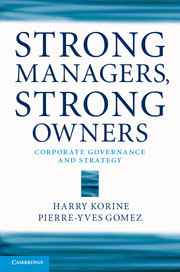Book contents
- Frontmatter
- Contents
- List of Figures
- List of Tables
- Foreword
- Acknowledgments
- Introduction
- Part I Changes in the identity of ownership and management
- Part II Changes in the form of ownership and organization
- 3 Change in legal structure
- 4 Change in organizational structure
- Concluding remarks
- Part III Changes in strategy
- Part IV Implications for corporate governance
- Notes
- Index
4 - Change in organizational structure
from Part II - Changes in the form of ownership and organization
Published online by Cambridge University Press: 05 December 2013
- Frontmatter
- Contents
- List of Figures
- List of Tables
- Foreword
- Acknowledgments
- Introduction
- Part I Changes in the identity of ownership and management
- Part II Changes in the form of ownership and organization
- 3 Change in legal structure
- 4 Change in organizational structure
- Concluding remarks
- Part III Changes in strategy
- Part IV Implications for corporate governance
- Notes
- Index
Summary
A change in ownership form requires the approval of shareholders and represents a major and rare event in the life of a business firm. A change in organizational structure, on the other hand, ostensibly has nothing to do with shareholders and occurs much more frequently. Should shareholders concern themselves with questions of internal organization? Reorganization stands for much more than the redrawing of organization charts. In fact, reorganization is one of the most far-reaching tools of change; it shifts the locus of power and affects how information is processed in the firm; as a result, reorganization almost always has significant long-term effects on the direction of the firm. This is why we devote a chapter to the topic of reorganization in a book about firm ownership, management, and strategy.
Point to watch: the broader effects of reorganization
Looking at reorganization as a purely internal matter of concern only to management and employees unjustly ignores the broader effects that reorganization can have. Reorganization can be good for some shareholders and bad for others and good for some managers and bad for others. It affects the balance of power in the firm, strengthening or weakening different actors and changing how information is processed and communicated. And yet, reorganization is typically left to consultants to prepare and managers to decide - only very rarely does the board of directors, or shareholders, get involved. This is a risk that boards and shareholders should not take lightly.
- Type
- Chapter
- Information
- Strong Managers, Strong OwnersCorporate Governance and Strategy, pp. 87 - 97Publisher: Cambridge University PressPrint publication year: 2013



